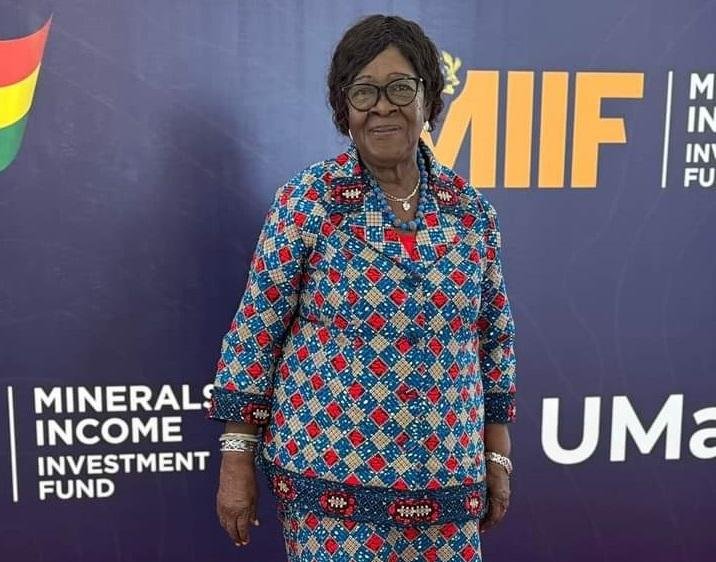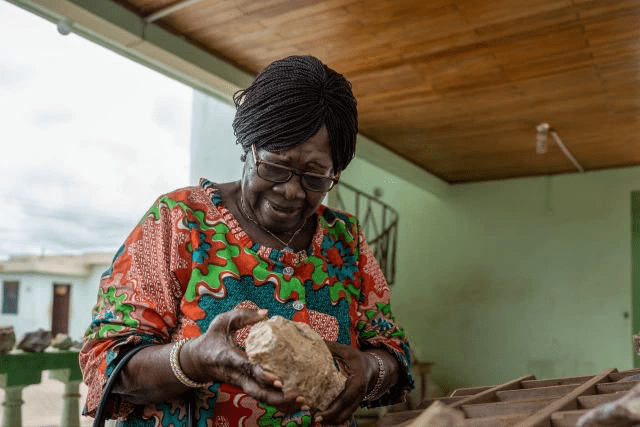Features
Mrs Alexandra Amoako-Mensah, discoverer of Lithium in Ghana

Mrs Amoako Mensah with CEO of Atlantic Lithium Keith Muller
In the heavily male-dominated geological industry in Ghana, one female stands out with a huge mark, creating an incredible path for others to emulate.
Geologist Mrs Alexandra Amoako-Mensah’s thesis in the 1970s led to the discovery of lithium in Ghana.
In her desperation to explore Ghana’s natural resource potential beyond the gold industry, an ambitious Amoako-Mensah engaged in a research-based thesis, supervised by Dr Oleg Von Knorring with the title, ‘Mineralogy and Geochemistry of Spodumene Pegmatites with Particular Reference to Spodumene Occurrences at Saltpond, Ghana.’ The thesis was published in 1971.

Spodumene pegmantites are generally known to be the main hard rock that houses the element lithium, which has realised a massive surge in demand for its use in electric vehicle batteries, globally considered to be essential in the transition to green energy era to combat climate change.
During her research which took place at Ewoyaa in the Central region, Mrs Amoako-Mensah had to surmount numerous physical and psychological challenges in order to complete the thesis.
“I went through a thick forest in search of spodumene-bearing pegmatites, relying solely on a hand-held compass and the unusual nature of my profession at the time attracted curious glances from colleagues and onlookers alike,” she said.

Little did she know that, her time-consuming and back-breaking research would be crucial in Ghana’s discovery of lithium which would essentially improve the socio-economic status of the country.
In 2016, following the discovery of lithium in West Africa, established geologist, Len Kolff in his search for pegmatite potential areas on the continent, came across Mrs Amoako-Mensah’s thesis.
The thesis, which focused on the region’s mineralogy, geochemistry and petrology, provided Kolff, now Head of Business Development and Chief Geologist at Atlantic Lithium, clear understanding on the potentials of Saltpond’s spodumene pegmatite which led to Ghana’s first official discovery of lithium in 2018.

Kolff said after the discovery, “Mrs. Amoako-Mensah’s thesis gave an in-depth insight into the mineralogy of pegmatites in the Saltpond area. This was critical to understanding the economic potential of the area’s lithium pegmatites, which proved to be a key part of the puzzle in the discovery of Ewoyaa.”
“Without Mrs. Amoako-Mensah’s thesis and the regional mapping that she completed, we may never have travelled to Ghana for the first time to follow up on it,” he added.
Fast forward, in October 2023, over five decades after Mrs Amoako-Mensah’s thesis, the government of Ghana granted Barari DV Ghana Limited (Atlantic Lithium’s Ghanaian subsidiary) a Mining Lease in respect of the Ewoyaa Lithium Project, putting the project firmly on track to become Ghana’s first lithium mine.
The project valued over US$5 billion is estimated to generate over 800 direct jobs for Ghanaians.
“I never envisaged that my work would contribute to Ewoyaa becoming a mining area and the focus of national discussions about lithium production. During my recent visit, I was amazed at the tremendous change that is underway at Ewoyaa and that, no doubt, will soon come from the commencement of lithium mining operations,” Mrs Amoako-Mensah mentioned during a recent visit by Atlantic Lithium to the Project site.
“I am excited because my project work has yielded fruit that will benefit Ghanaians. I am grateful to God that I am alive to experience lithium mining in Ghana,” she added.
She was a geologist at the former Geological Survey Department (now the Geological Survey Authority of Ghana) from 1966 to 1972, where she climbed the ranks to become the Head of the GSD’s laboratories at its headquarters in Accra and in Saltpond.
From 1972-1997, she worked at the former Industrial Research Institute (now Institute of Industrial Research of the Council for Scientific and Industrial Research; ‘CSIR’), where she rose to the position of Chief Research Officer.
During her time at the institute, she became Head of the Material Science Division, before serving as a Director from 1987 to 1997. She then served as Director at the CSIR Head Office from 1997 until her compulsory retirement in 2000.
She also served on the boards of many local and international companies and technical committees, including the United Nations (UN) Scientific and Technical Committee on the International Decade for Natural Disaster Reduction (IDNDR), the Ghana Broadcasting Corporation (GBC), the Ghana National Petroleum Corporation (GNPC), the Minerals Commission and the Governing Council of GNPC Learning Foundation.
She was also the Secretary General of the Geological Society of Africa between 1988 and 1993 and President of the Ghana Institution of Geoscientists from 2006 until 2017.
She is the sixth of nine children, born in Takoradi to parents Samuel Sey Afful and Mary Amoasiwa Quaye Afful from Apam in the Central region.
She went to Wesley Girls’ High School, Cape Coast in 1960 where she was awarded a scholarship to read Geology at the St. Petersburg State University in Russia.
She returned to Ghana in 1966 and joined the Ghana Geological Survey where she met Prof. Shacketon, a visiting professor at the University of Ghana. Upon recognising her potential, Prof Shackleton offered her admission to Leeds University, UK to unable her advance in her academic research.
Supported by her late husband, Dr Alfred Kwadwo Archer Amoako-Mensah, she travelled to Leeds to pursue a Master of Philosophy in Geochemistry in 1971.
Currently, Mrs. Amoako-Mensah serves as the Board Chairperson of SAL Consult Limited, a multi-disciplinary water and environmental consultancy company, and remains a member of Women in Mining, Ghana.
Now 83 and a proud mother to her four sons, Alfred, Michael, Samuel and Joseph-Emmanuel, Mrs. Amoako-Mensah resides in Accra.
By Michael D. Abayateye
Features
Who knows tomorrow?
Recently a friend posted a sad news on his Facebook page, announcing the death of a school mate who had passed away, suddenly. The report had it that he was on his way to the airport to take a flight to Ghana.
I am sure this man had already informed the wife or a friend or a work colleague at work that he was returning home but he was not to return as a human being but as a dead body.
Such is life and so we need to be circumspect in how we go about things in life. The Bible reminds us that we are like grass which at one point in time looks elegant and the next moment becomes withered according to Psalm 90:5 and 6. It is for this reason that we need to guard our hearts with the word of God so that we shall be motivated to do the right thing, at all times.
This will enable us live on this planet, free from all sorts of troubles in our personal lives, even if we ignore the question of Heaven and Hell. Living a disciplined life delivers us from any kind of trouble as the Bible declares in Galatians 5:23 that against such there is no law.
The uncertainty surrounding our lives on earth is the more reason why people should commit their lives into the hands of the one who created it, in the first place unless you believe that the world created itself and that it appeared from nowhere.
Otherwise, the logical thing to do is to recognize the authority of the creator and surrender to his Lordship. Heaven is real and Hell is real, so for us who know the truth and have received Jesus as our Lord and Saviour, the onus lies on us to encourage our relations who have not believed and received Jesus into their lives, to do so.
We are a couple of days from another Easter Resurrection celebration and an opportunity to reflect on our lives in relation to the significance of Easter. In the Bible, the only occasion Jesus, Saviour of the world commands us to celebrate is his death and resurrection.
He never commanded his followers to celebrate his birth but like everything else, we chose to ignore Jesus’s instructions and decided to do what pleases us, just like our forefather and mother in the Garden of Eden.
Let us deliberately choose to do things differently as Christians this Easter, so we can really benefit from all the blessings that the celebration of the death and birth of Jesus, has on offer. Doing the same thing over and over and expecting a different result is definitely insanity.
I choose to be different this Easter and I am believing God for a newness of life so God’s glory would be revealed in me to draw the unsaved to him. It is only when people especially the unsaved, see the character of Christ in us, that they can be convinced about the authenticity of Jesus, as Saviour of the world, who can bring transformation in their lives too.
This is what would motivate them to surrender their lives to Jesus Christ. Let us make this Easter a memorable one that will be cherished for a long time. It is also a period for reconciliation and it would be great if in the spirit of Easter, we would try to reach out to those who have wronged us or have a grudge against us.
This would demonstrate that we have indeed accepted Jesus and that our religious posture is not a sham. May the good Lord grant us the grace to love our neighbours as ourselves, demonstrating the love of God in the process.
Those who have lost their loved ones and Easter brings sad memories, may the good Lord comfort and strengthen you. God bless.
.NB: ‘CHANGE KOTOKA INTERNATIONAL AIRPORT TO KOFI BAAKO INTERNATIONAL AIRPORT’
Features
Cosmetic deformities
COSMETIC deformities refer to physical imperfections or abnormalities that affect an individual’s appearance, often causing emotional distress and impacting their quality of life.
These deformities can be congenital, acquired, or result from various medical conditions or treatments. This article provides an in-depth exploration of cosmetic deformities, their types, causes, effects, and treatment options.
Types of cosmetic deformities
Cosmetic deformities can affect various parts of the body, including the face, skin, hair, nails, and teeth. Some common types of cosmetic deformities include:
1. Facial deformities: Congenital or acquired abnormalities affecting the shape, structure, or appearance of the face, such as cleft lip and palate, facial paralysis, or facial asymmetry.
2. Skin deformities: Conditions affecting the skin’s texture, tone, or appearance, such as acne, scars, birthmarks, or skin discoloration.
3. Hair deformities: Abnormalities affecting the hair’s growth, texture, or appearance, such as alopecia, hirsutism, or hair loss due to medical conditions or treatments.
4. Nail deformities: Conditions affecting the shape, size, or appearance of the nails, such as nail fungus, nail psoriasis, or nail trauma.
5. Dental deformities: Abnormalities affecting the shape, size, or appearance of the teeth, such as tooth decay, tooth loss, or malocclusion.
Causes of cosmetic deformities
Cosmetic deformities can result from various factors, including:
1. Genetics: Congenital conditions or inherited traits can cause cosmetic deformities.
2. Trauma: Injuries or accidents can result in cosmetic deformities, such as scars or facial trauma.
3. Medical conditions: Certain medical conditions, such as acne, psoriasis, or eczema, can cause cosmetic deformities.
4. Treatments and procedures: Medical treatments, such as chemotherapy, radiation therapy, or surgery, can result in cosmetic deformities.
5. Aging and environmental factors: Aging, sun exposure, and environmental factors can contribute to cosmetic deformities, such as wrinkles, fine lines, or age spots.
Effects of cosmetic deformities
Cosmetic deformities can have significant emotional and psychological effects on individuals, including:
1. Low self-esteem: Cosmetic deformities can lead to feelings of insecurity, self-consciousness, and low self-esteem.
2. Social anxiety: Individuals with cosmetic deformities may experience social anxiety, avoiding social interactions or feeling embarrassed in public.
3. Emotional distress: Cosmetic deformities can cause emotional distress, including depression, anxiety, or stress.
4. Impact on quality of life: Cosmetic deformities can affect an individual’s quality of life, impacting their relationships, career, or overall well-being.
Treatment options for cosmetic deformities
Various treatment options are available to address cosmetic deformities, including:
1. Surgical procedures: Surgical procedures, such as reconstructive surgery, cosmetic surgery, or dermatological surgery, can correct or improve cosmetic deformities.
2. Non-surgical treatments: Non-surgical treatments, such as laser therapy, chemical peels, or microdermabrasion, can address cosmetic concerns, such as skin texture, tone, or appearance.
3. Medical treatments: Medical treatments, such as topical creams, oral medications, or injectable treatments, can address cosmetic concerns, such as acne, hair loss, or nail deformities.
4. Prosthetic and orthotic devices: Prosthetic and orthotic devices, such as wigs, hairpieces, or dental prosthetics, can help individuals with cosmetic deformities.
5. Counselling and therapy: Counselling and therapy, such as cognitive-behavioral therapy or psychotherapy, can help individuals cope with the emotional and psychological effects of cosmetic deformities.
Conclusion
Cosmetic deformities can have significant emotional and psychological effects on individuals, impacting their quality of life and overall well-being.
Understanding the types, causes, and effects of cosmetic deformities is crucial in addressing these concerns.
Various treatment options are available, ranging from surgical procedures to non-surgical treatments, medical treatments, prosthetic and orthotic devices, and counselling and therapy.
By seeking professional help and support, individuals with cosmetic deformities can improve their appearance, boost their self-esteem, and enhance their overall quality of life.
Reference
1. “Cosmetic Deformities” by the American Society of Plastic Surgeons







